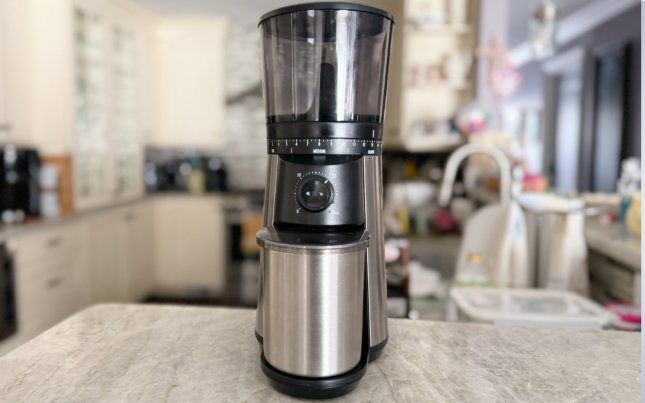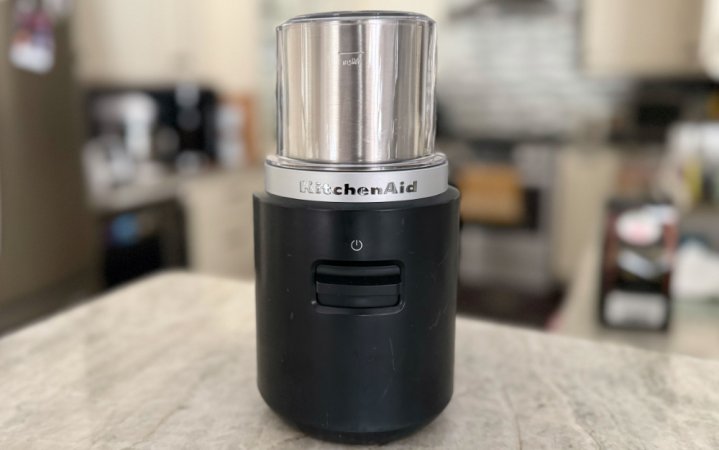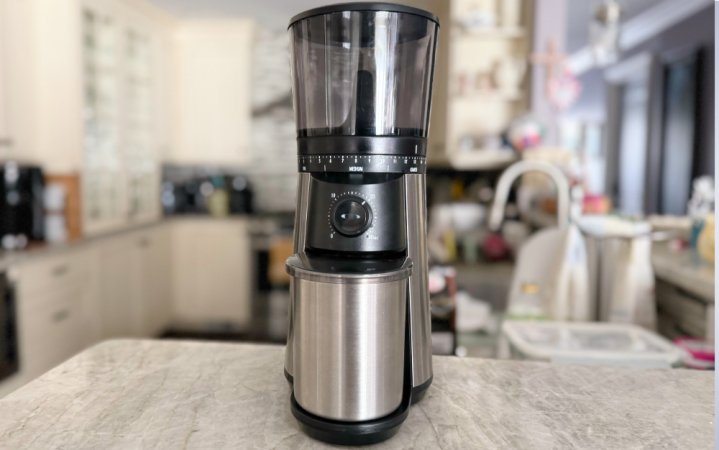We may earn revenue from the products available on this page and participate in affiliate programs. Learn more ›

Whether rocking a classic brewer or a fancy pour-over or press, you need a coffee grinder to pulverize those beans. Believe it or not, your grinder’s quality will affect your coffee’s quality. The oft-overlooked grinder is actually a crucial piece of equipment when it comes to crafting the perfect cup: You get maximum flavor from uniformly cut beans, and not every grinder can deliver those. Finding the best coffee grinders for you and your needs means looking at the price point, whether you want something manual or electric, and whether you prefer burred beans to bladed ones—and we have the options that address all these considerations and more.
- Best overall: Baratza Encore Conical Burr Coffee Grinder
- Best splurge: Baratza Forte BG (Brew Grinder)
- Best design: Fellow Ode Brew Grinder
- Best portable: KitchenAid Go Cordless Blade Coffee Grinder
- Best manual: JavaPresse Manual Coffee Grinder with Adjustable Settings
- Best value: OXO Brew Conical Burr Coffee Grinder
How we chose the best coffee grinders
We chose the best coffee grinders based on a mix of research and hands-on testing. Our methodology took into consideration whether the grinder was manual or electric, a burr or blade grinder, and even the type of coffee beans one can use. This is a monotasking appliance, but that doesn’t mean it’s simple. In the case of the coffee grinders we tested, our assessments covered their ease of use, ease of cleanup, and overall performance. Price was also a consideration, and we’ve diligently presented options across a wide cost spectrum.
The best coffee grinders: Reviews & Recommendations
No matter how you prepare your coffee—whether pour-over, French press, espresso, etc.—freshly ground beans take the experience to a new level. Here are the best coffee grinders to help you get your caffeine fix at home, at the office, or even on the go.
Best overall: Baratza Encore Conical Burr Coffee Grinder
Best overall
Easy to Use

Pros
- 40 grind settings
- Single-button design
- High-torque motor
Cons
- Low capacity
Specs
- Power source: Electricity
- Size: 6.3 x 4.7 x 13.8 inches
- Capacity: 5 ounces
- Price: $149.95
Baratza says its Encore Conical Burr Coffee Grinder was designed for beginners, which is great if you’re making the leap from using pre-ground coffee to whole beans. Its 40 grind settings may seem intimidating at first, but researching the correct coarseness of your coffee beans based on the brew you’re making will allow you to make the perfect cappuccino every time. Over time, the Encore’s numerous grind settings will be a vital feature rather than a source of frustration.
The Encore’s approachable design is comprised of an on/off switch, which will continuously grind beans, and a single pulse button to engage the machine’s high-torque motor in short bursts. A few pulses will yield enough coffee for a single cup, while letting the machine run for half a minute should provide enough grounds for a group. Just be mindful of this coffee grinder’s relatively low capacity, which means you’ll have to refill the machine on a more regular basis.
Best splurge: Baratza Forte BG (Brew Grinder)
Pro Grade
Pros
- Built-in scale
- Digital screen
- 260 grind settings
Cons
- Price
Specs
- Power source: Electricity
- Size: 5.12 x 7.09 x 14.17 inches
- Capacity: 10.58 ounces
- Price: $895
Yes, Bartaza’s Forte BG costs several times more than our other recommendations. Still, it has features that professional coffee makers will want and that everyone who uses it could appreciate. Its two stand-out features are a built-in electronic scale to ensure each cup of coffee you make has the same amount of grounds and a digital screen, allowing you to switch between its grind settings, set the grinder on a timer, and more. Bartaza outfitted this coffee grinder with 260 grind settings, so you can get pinpoint precision when making your grounds.
If you’re willing to invest in a machine like this, the chances are high that you’ll have a similarly tricked-out coffee maker. Once you’ve found the ideal grind setting for your preferred cup of coffee, you can save it as a preset so it’s accessible at the push of a button. Bartaza’s Forte BG is a no-compromise coffee grinder and is likely to be the only one you’ll ever need if you make the investment.
Best design: Fellow Ode Brew Grinder
Cafe Quality on Your Countertop
Pros
- Aluminum construction
- Automatic stop function
- Quiet operation
Cons
- Low capacity
Specs
- Power source: Electricity
- Size: 9.5 x 4.7 x 9.4 inches
- Capacity: 3.5 ounces
- Price: $199
Fellow’s sleek-looking Ode Brew Grinder is sure to spruce up your countertop, but its performance matches the aesthetic value of its aluminum frame. The Ode features 11 grind settings, with 31 steps in between to give you ample space for experimentation. Fellow says its settings were specifically designed to produce the optimal grounds for AeroPress, pour-over, French press, and cold brew beverages. The heart of this appliance is its professional-level 64mm flat burrs, which grind beans consistently.
Despite their size and power, Fellow touts this coffee grinder’s quiet operation. One of the Ode Brew Grinder’s most user-friendly features is its automatic stop function, which will shut off its motor when it senses its hopper is empty. This is both a cue to add more beans (if necessary) and to conserve energy. This coffee grinder can’t hold a lot of beans at once, so you’ll likely have to replenish it regularly if you drink more than one cup of coffee per day, or prefer a stronger cup.
Best portable: KitchenAid Go Cordless Blade Coffee Grinder
Pros
- Runs on a rechargeable battery
- Simple design
- Works very well
Cons
- You’ll need to remember to charge it
Specs
- Power source: Battery
- Size: 4.41 x 5.29 x 8.41 inches
- Capacity: 4 ounces
- Price: $129.99
KitchenAid’s new Go line of battery-powered appliances includes a coffee grinder, and it’s easily the best powered model you can take with you anywhere. It’s small enough to cart around in a backpack or carry-on bag and can run for up to six minutes per charge. In our tests, that’s enough time to get several cups of finely ground beans before reaching for a USB-C cable. If you’re worried about running out of juice, you can always pick up a spare battery. Using this cordless coffee grinder was straightforward: We loaded its hopper up with beans, placed the plastic cover on top, twisted the cover to lock it in place, and pushed down on its single power switch.
This coffee grinder has no set grind settings, so you’ll need to watch the grounds as they’re being crushed to determine when they’ve reached the correct consistency. We were able to get course grounds in about 15 seconds when the hopper was full, and kept the grinder running for a full minute to get powder-like results. This coffee grinder was short enough that we could easily keep track of the state of our grounds to prevent ourselves from overgrinding while it was on a countertop.
You’ll need to remember to keep this coffee grinder’s battery topped up, which can be tedious in a world where every portable gadget requires power management, but you’ll be rewarded for this minimal amount of maintenance. This is the best option if you’re serious about making freshly ground coffee in moderate to high quantities on the go.
Best manual: JavaPresse Manual Coffee Grinder
No Power Needed

Pros
- No outlet required
- Compact design
- Price
Cons
- Requires elbow grease
Specs
- Power source: Hand crank
- Size: 1.8 x 1.8 x 7.5 inches
- Capacity: N/A
- Price: $39.94
If you’d like to take a coffee grinder with you on a camping trip or only want to enjoy a high-quality cup on occasion, JavaPresse’s Manual Coffee Grinder is the one to get. Turning its crank a few times will yield enough grounds for a couple of cups of coffee, which isn’t bad considering you can easily pack this grinder in a backpack. That said, using this coffee grinder will take more effort than an electric one, so be prepared to put in some effort to get your grounds.
It’d be easy to assume JavaPresse would have to make big sacrifices to achieve this manual grinder’s small size, but that’s not true. It features 18 grind settings, is significantly quieter than using an electric grinder, and uses ceramic burrs that were designed to last several times longer than stainless steel ones. If you want to make sure you’ll be able to make fresh coffee the way you like it while you’re on vacation or a business trip, JavaPresse’s Manual Stainless Steel Coffee Grinder is the one to get.
Best value: OXO Brew Conical Burr Coffee Grinder
Great Value
Pros
- 16 different grind settings
- Timer to control the length of its grind sessions
- Easy to maintain
Cons
- Difficult to see how many grounds are in the container
Specs
- Power source: Electricity
- Size: 6.8 x 11.8 x 14.8 inches
- Capacity: 12 ounces
- Price: $99.95
OXO’s Brew Conical Burr Coffee Grinder is another compact, beginner-friendly option for those beginning their adventures in whole-bean coffee making. It features 15 settings that produce grinds ranging from the texture of loose-leaf tea to confectioner’s sugar. Its relatively large hopper can hold a couple of cups worth of beans at a time, and the grinder had no problem continuously pulverizing them with consistent results. While testing this coffee grinder, one of our favorite features was its built-in timer, which allows you to continuously grind beans in intervals up to 30 seconds. Once you know how the volume of grounds this machine will produce on your preferred grind setting, you can make the perfect amount with the twist of a knob.
We found the grind setting numbers on this coffee grinder easy to read, and OXO even broke them down into fine, medium, and coarse, so you know which way to turn the hopper. Ironically, the only part of this coffee grinder showing signs of wear after months of use is the company’s logo, which is printed in the middle of its grind button. Once we were done grinding our beans, it was equally simple to remove the hopper and grounds container to wash them.
Overall, we found this coffee grinder to be fast, easy to operate, and it produced consistent results regardless of our preferred grind setting. The grounds container’s stainless steel construction made it impossible to see how full it was at a glance—the top cover is made out of see-through plastic, but was difficult to keep an eye on at any angle—but we never ran into the issue of it overflowing if we stuck to OXO’s 30-second grind intervals. You can’t go wrong here if you’re looking for a full-powered electric coffee grinder on a budget.
Don’t want to deal with a kitchen scale to measure the perfect amount of your grounds? OXO has a solution for that in the OXO Brew Conical Burr Coffee Grinder with 38 Settings and Scale (which, admittedly, adds substantially to the price). However, you’ll still need to pick up a milk frother for those perfect espresso-based beverages.
What to consider when shopping for the best coffee grinders
Baristas and javaheads alike agree that one of the keys to a perfect cup of joe is using fresh, uniformly ground beans; to get those, you need one of the best coffee grinders. Knowing how to grind your beans for the particular type of coffee you’re making (will it be iced coffee, cold brew, or a crema-rich shot for that latte drink, etc.) is also crucial. (Here’s a secret: Start with less beans.) If you don’t know your burrs from your blade or your flat-tops from your conicals, read on to up your coffee game instantly.
Burr vs. blade grinders
As you start to shop, you’ll quickly notice two words coming up again and again: burr and blade. A burr grinder (or burr mill) works by crushing beans between two rotating burrs, or small rotary cutting tools. (Within the world of burr grinders, there are two types: conical and flat. Conicals will typically cost you more than flat.) A blade grinder features one big blade that rotates and slices up your beans as it goes. In general, burr grinders are thought to be more precise (and therefore pricier) because they chop grounds in a more uniform way than blades. In broad strokes, a blade grinder works faster and is cheaper; a burr grinder offers more control and better taste, but it’ll also cost you more.
Manual vs. electric grinders
As you could probably guess, the big difference between these two options is how much elbow grease you feel like putting into grinding your beans. Manual grinders are typically smaller than their electric counterparts and don’t require electricity, so they’re perfect for traveling. They’re more affordable than automatic grinders and allow you to control the size of your grind better. The biggest benefit to an electric grinder is ease and speed of use—no physical effort is required, but you will need an outlet.
How tech-savvy and/or comfortable you are with settings is also a factor: The more precise you want your electric grinder to be, the more settings you’ll have to deal with (because the grind size for an espresso drink is different from that for straight coffee). If you don’t want to deal with so many options (or spend as much) but still want something electric, pick one with minimal settings.
Coffee bean preference
You may be asking yourself: should I choose my grinder based on how I make my coffee and what kind of coffee I drink? Yes! Well, sort of. The way you take your coffee will determine how finely you grind your beans. For example, French presses and cold brew coffee work best with a coarse grind; espresso should be fine. (In the middle is an assortment of slightly different ground sizes, like medium-coarse for pour-over and medium for a drip machine.) If you’ve ever had beans ground at the grocery store, you’ve likely had to choose the size of your grind. Over- or under-grinding beans for the way you brew can result in a deficit of flavor.
FAQs
Yes! A coffee grinder is one important factor in the equation that is making a good cup of coffee. You want something that grinds beans uniformly and—if you plan to brew for multiple types of makers—can adapt (i.e., give you options like coarse, medium, and fine). If you’re always disappointed that your at-home coffee never tastes quite as good as the coffee house stuff, your first step in improving your java game is investing in a coffee grinder.
A burr grinder is one that breaks up beans by crushing them, like a mill. (A blade grinder chops beans with, well, a blade). Burr grinders are said to cut beans more precisely and evenly, delivering better flavor. Within the burr world, there are two kinds of grinders: conical and flat. A conical burr grinder has a cone-shaped center burr and outer serrated burr; a flat one features two round, facing burrs that turn out grinds that are even more precise than their conical brethren (but they also make more noise).
How long you keep at it with a manual grinder differs based on what kind of grounds you seek and how many beans you want to break. As you’d probably guess, the finer the grind, the longer it takes; the same goes for bigger volumes of beans. The best thing to do is start out slow and check your beans every couple of seconds. You can always grind more, but you can’t go back and grind less. In general, a coarse grind takes about 10 seconds and a fine grind takes around 30. A medium grind takes, well, a medium amount. But trial and error is your friend!
Final thoughts on the best coffee grinders
- Best overall: Baratza Encore Conical Burr Coffee Grinder
- Best splurge: Baratza Forte BG (Brew Grinder)
- Best design: Fellow Ode Brew Grinder
- Best portable: KitchenAid Go Cordless Blade Coffee Grinder
- Best manual: JavaPresse Manual Coffee Grinder with Adjustable Settings
- Best value: OXO Brew Conical Burr Coffee Grinder
The best coffee grinders are ones that are right for your budget, have options to satisfy every coffee drinker in your house (e.g., you like an espresso, but your roommate wants cold brew), and are suited to get every last bit of flavor out of those power-packed little magic beans and into your travel mug. In general, that probably means springing for a burr grinder over a blade one, but beyond that, it’s dealer’s choice among our picks above!







